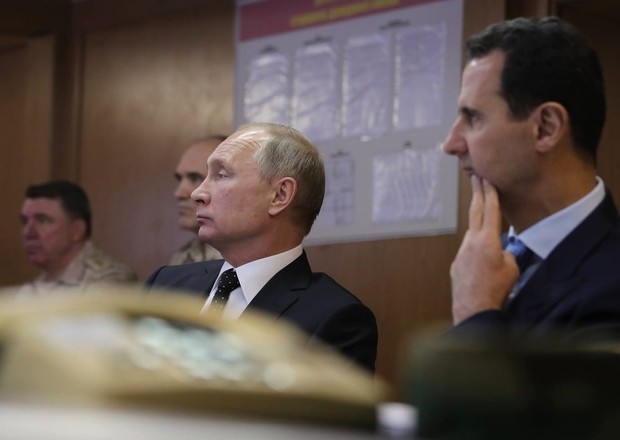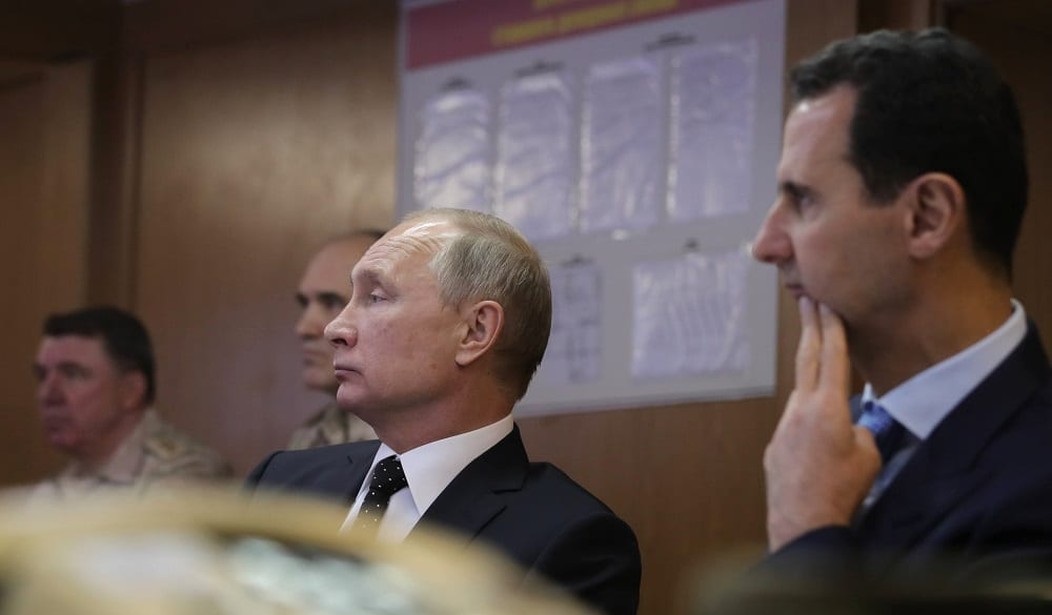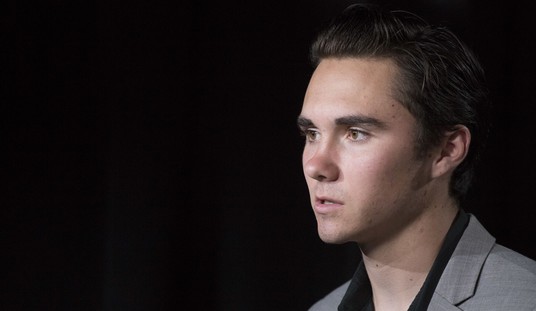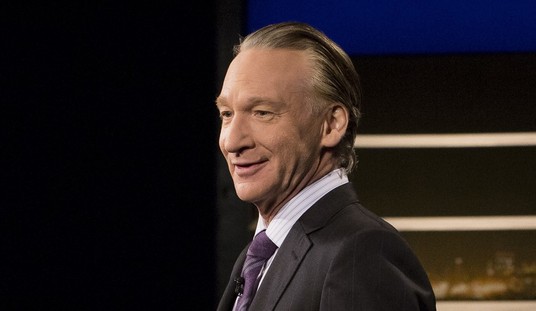
Russian President Vladimir Putin, center, and Syrian President Bashar Assad, 2nd right, meet with military personnel at the Hemeimeem air base in Syria, on Monday, Dec. 11, 2017. Declaring a victory in Syria, Putin on Monday visited a Russian military air base in the country and announced a partial pullout of Russian forces from the Mideast nation. (Mikhail Klimentyev, Sputnik, Kremlin Pool Photo via AP)
Over the weekend, the Syrian city of Douma was attacked by Assad’s forces using some sort of a chemical weapon.
Right now a lot of people are working on the assumption that this was a nerve agent attack and blaming Trump, naturally, for saying he wants to pull out of Syria as the cause for the attack:
John McCain links the chemical attack in Syria to Trump signaling that the U.S. would withdraw from Syria. pic.twitter.com/KZyHwhIRc6
— Kyle Griffin (@kylegriffin1) April 8, 2018
We don’t have any evidence that is the case, in fact, a much better guess is that the attack was another chlorine attack. The best evidence from the scene, at this point, indicates it was a chlorine attack:
“Patients have shown signs of respiratory distress, central cyanosis, excessive oral foaming, corneal burns, and the emission of chlorine-like odor,” the Syrian American Medical Society said in a statement. “During clinical examination, medical staff observed bradycardia, wheezing and coarse bronchial sounds. One of the injured was declared dead on arrival. Other patients were treated with humidified oxygen and bronchodilators, after which their condition improved. In several cases involving more severe exposure to the chemical agents, medical staff put patients on a ventilator, including four children. Six casualties were reported at the center, one of whom was a woman who had convulsions and pinpoint pupils.”
The very fact that nearly all reports from the scene talk about people “choking” indicates it was not a nerve agent attack as that isn’t a noticeable symptom (the mnemonic SLUD–Salivate, Lachrymate, Urinate, Defecate–is the sequence of events in the case of nerve agent poisoning and there will be about 0% survivors among those exposed).
Here is one of the horrifying videos coming out of Douma in Syria tonight showing the aftermath of what seems to be a chemical gas attack. These people were hiding underground from the bombing, leaving them more vulnerable to gas. pic.twitter.com/mm9jgBZ4V8
— Liz Sly (@LizSly) April 7, 2018
If it was chlorine–and no one is yet calling it nerve gas–then this attack, though it was horrific, has been allowed by the United States ever since Assad crossed Obama’s “red line” back in 2012. This is at least the third Syrian town–maybe the fourth because reporting on the subject is not all that clear–hit by chlorine in 2018 and it is the second time this year that this particular town has been hit. On the average, it looks like the Syrian regime has been using chlorine about a half-dozen times a year since 2014. Because chlorine is an industrial chemical, its use has not been considered a “chemical weapon” in the same class as Sarin.
As you recall, Assad used Sarin last April and was targeted by an extensive cruise missile attack that grounded most of his air force for the past year. (A note here: a lot of anti-Trump people have referred to this as the “empty airfield attack.” This is just stupid or dishonest. The cruise missile attack targeted hangars, repair facilities, supply bunkers, crew quarters, and fuel supplies. The least vital part of an airfield is the runway which is ridiculously easy to repair.)
Since then the administration has let it be known that it is not happy with the wink-and-nod given to the use of chlorine. From March 5 of this year:
The Trump administration has considered new military action against the Syrian government in response to reports of ongoing chemical weapons use, officials said, raising the prospect of a second U.S. strike on President Bashar al-Assad in less than a year.
President Trump requested options for punishing the Assad government after reported chlorine gas attacks — at least seven this year — and possibly other chemicals affecting civilians in opposition-controlled areas.
In a Feb. 25 incident, residents and medical staffers in a rebel-held Damascus suburb, Eastern Ghouta, described symptoms associated with chlorine exposure. One child died, medical staffers reported.
The president discussed potential actions early last week at a White House meeting that included Chief of Staff John F. Kelly, national security adviser H.R. McMaster and Defense Secretary Jim Mattis, officials said.
…
One senior administration official said that Mattis was “adamantly” against acting militarily in response to the recent chlorine attacks and that McMaster “was for it.”
Just to review this for a second, President Trump was the guy driving this conversation, not a disinterested and uninterested bystander.
This brings us to today and the question of if will we act if this is chlorine and, if so, how will we act?
The UN has called for an emergency meeting on the attack
We along with 8 other members have called for an emergency Security Council mtg tomorrow in reference to the horrible chemical weapons attack on innocent civilians in Syria. This is becoming all too common. Strong action is needed. pic.twitter.com/Vt3L5fjVla
— Archive: Ambassador Nikki Haley (@AmbNikkiHaley) April 8, 2018
This is what the rest of the day looks like:
#Syria Update:
•Russia accuses Israel of Missile strikes near Homs, is not happy
•UNSC meets 3 pm ET
•France & US assessing material + possible joint response
•Trump Meeting military leadership tonight (pre planned)
•Saudi MBS in Paris (preplanned) to meet Hariri— Joyce Karam (@Joyce_Karam) April 9, 2018
But more importantly, President Trump has signaled that he’s displeased:
Many dead, including women and children, in mindless CHEMICAL attack in Syria. Area of atrocity is in lockdown and encircled by Syrian Army, making it completely inaccessible to outside world. President Putin, Russia and Iran are responsible for backing Animal Assad. Big price…
— Donald J. Trump (@realDonaldTrump) April 8, 2018
….to pay. Open area immediately for medical help and verification. Another humanitarian disaster for no reason whatsoever. SICK!
— Donald J. Trump (@realDonaldTrump) April 8, 2018
If President Obama had crossed his stated Red Line In The Sand, the Syrian disaster would have ended long ago! Animal Assad would have been history!
— Donald J. Trump (@realDonaldTrump) April 8, 2018
These signs all say that in the near future, probably within the next 48-hours, that we will strike because otherwise, Trump is going to be criticized for backing down.
If we make an extensive strike against regime targets and if we do it in conjunction with France,
White House: US and France will coordinate a 'strong, joint response' on Syria after suspected chemical attack https://t.co/v9URjtCZvE pic.twitter.com/6dA7AUiIiT
— Business Insider (@businessinsider) April 9, 2018
then this marks a major shift in policy. First, it is imposing a cost on Assad for using a weapon the international community has allowed him to use for four years. Second, someone other than the US might be involved. I’m not a big believer in coalition operations for all the good reasons that Clausewitz laid out, but having someone else involved makes this more than a US-Syria issue.
NEW: Defense Sec. James Mattis on possible action against Syrian Pres. Assad in response to suspected chemical attack in Douma, Syria: "I don't rule out anything right now." https://t.co/Ak2P06Hz60 pic.twitter.com/TverKz6Rcm
— ABC News (@ABC) April 9, 2018













Join the conversation as a VIP Member